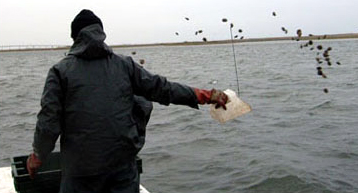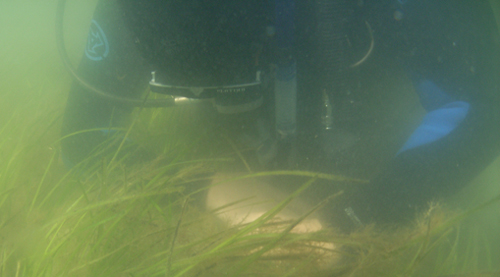South Shore Estuary Eelgrass and Bay Scallop Restoration Planning Project
Methods
TASK 1 - .Monitoring
of existing eelgrass meadows(Year 1 & 2)
Prior to initiating any work, it
will be necessary to monitor existing eelgrass meadows for relative health and
restoration potential. Scheduling of field work is based on the phenology of
eelgrass in the region. Since temperature is one of the most significant factors
controlling plant growth, development, and flowering, monitoring will begin (~April)
with deployment of automatic bottom temperature loggers at all extant meadows.We would expect to monitor for natural seedling recruitment in existing meadows
in the early spring April/May. Counts of flower and seed yield will take place
in late June. Monitoring of other growth parameters would take place in July/August.
Overall, monitoring would include measurement of stem density, shoot length,
epiphyte biomass, co-occurrence of macroalgae, above and below ground biomass,
sediment texture and organic matter analysis.
TASK 2 – Monitoring
for existing scallops and planting site selection ( Year 1 - early spring)
Before a bay scallop seeding program can be developed it is necessary to determine
location and extent of existing populations. This data along with observations
regarding bottom type, presence of SAV/macroaglae (to be completed in TASK 1),
predator counts and other characteristics will be used to determine the most
suitable sites for future seeding efforts. Planting sites will be selected based
on the combination of factors that is most favorable to the growth and survival
of the bay scallop.
TASK 3 – Planting Suitability Index Model (Year 1)
Conduct field reconnaissance to collect data necessary to complete the planting
suitability index model. This data would include measurement of sediment texture,
and organic matter content, depth range of existing meadows, deployment of epiphyte
monitoring arrays at existing meadows and potential planting sites. Additional
data to be gathered from various sources includes, but is not limited to areas
closed to shellfishing, current shellfishing activity, nutrient levels, light
attenuation, mooring and boating activities.
 TASK 4 – Seed
collection, handling and planting (Year 1 & 2) TASK 4 – Seed
collection, handling and planting (Year 1 & 2)
In order to develop a comprehensive restoration plan seeds are the most likely
propagule source. Before seeds can be utilized it is necessary to assess the
potential for seed yield for each meadow. This work would involve measuring
flowering shoot occurrence per unit area, spathe number per flowering shoot
and seed number per spathe in existing meadows. This information would be used
to develop a theoretical seed yield number that would be necessary if large-scale
seeding is to be used for restoration purposes. We propose to collect ~500,000
seeds from several extant meadows in the SSER for use in test plantings at three
to four locations selected as part of the site selection work (above). Seed
collection would occur in late June/early July. Most of the flowers would be
transferred to Cornell’s eelgrass nursery facility for processing and
storage until planting in September or October. A small number of flowers may
also be deployed immediately upon collection using Cornell’s Buoy Deployed
Seeding System that was developed for use in the Peconic Estuary.
TASK 5 – Bay
scallop plantings (Year 1 & 2)
Based on the results of the field observations and site selection work, several
sites will be chosen for small-scale plantings of bay scallops. During late
spring approximately 10,000 brood stock with an average shell height of 35 mm
will be released in a defined area at each of 3 to 5 sites.
TASK 6 - Monitoring of test eelgrass plantings (Year 2)
In order to assess the effectiveness of the previous-years plantings it is necessary
to conduct field monitoring of the planting sites. Monitoring of seeded sites
begins in April with initial observations of seedling emergence. Later in the
season (June) when the plants are larger and easier to observe seedling counts
will be conducted at each planting site. Following this, seedling plots will
be observed in late summer/early fall to determine the effect of peak water
temperatures on the long term survival. TASK 7 - Monitoring
of bay scallop seeding (Year 1 & 2)
In order to assess the effectiveness of the each year’s plantings it is
necessary to conduct field monitoring of the planting sites. Monitoring will
consist of deployment of numerous spat collectors located in proximity to the
seeding areas. Depending on gonadal development and anticipated spawning time
collectors will likely be deployed in early July. Following deployment each
collector will be checked weekly for signs of spat fall. Monitoring of spat
will also take place in beds where brood stock were deployed, as well as nearby
adjacent beds.
<<Back to SSE Project Overview
<<Back to Current Projects |


 TASK 4 – Seed
collection, handling and planting (Year 1 & 2)
TASK 4 – Seed
collection, handling and planting (Year 1 & 2)